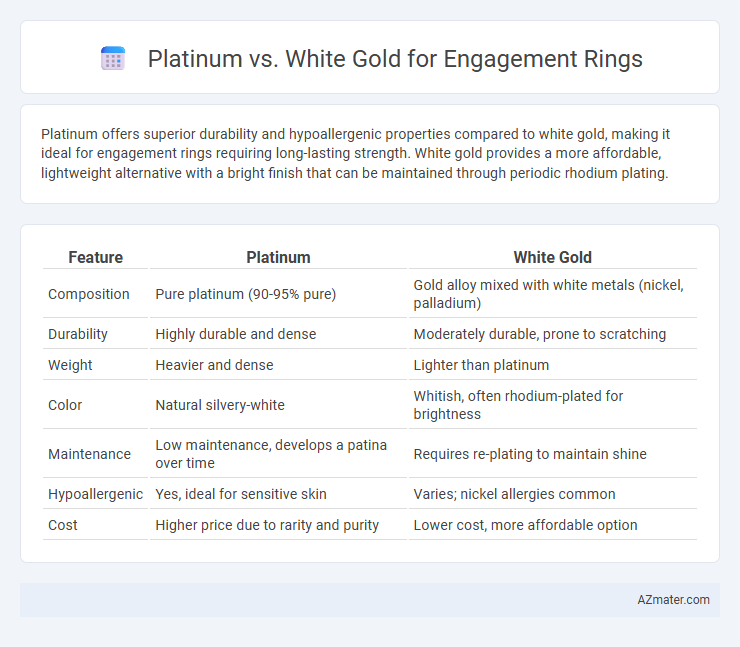Platinum offers superior durability and hypoallergenic properties compared to white gold, making it ideal for engagement rings requiring long-lasting strength. White gold provides a more affordable, lightweight alternative with a bright finish that can be maintained through periodic rhodium plating.
Table of Comparison
| Feature | Platinum | White Gold |
|---|---|---|
| Composition | Pure platinum (90-95% pure) | Gold alloy mixed with white metals (nickel, palladium) |
| Durability | Highly durable and dense | Moderately durable, prone to scratching |
| Weight | Heavier and dense | Lighter than platinum |
| Color | Natural silvery-white | Whitish, often rhodium-plated for brightness |
| Maintenance | Low maintenance, develops a patina over time | Requires re-plating to maintain shine |
| Hypoallergenic | Yes, ideal for sensitive skin | Varies; nickel allergies common |
| Cost | Higher price due to rarity and purity | Lower cost, more affordable option |
Understanding Platinum and White Gold
Platinum is a naturally white, dense metal known for its durability and hypoallergenic properties, making it ideal for engagement rings that require long-lasting strength and minimal maintenance. White gold is an alloy of gold mixed with white metals like palladium or nickel, often coated with rhodium to enhance its shine and whiteness, but it may require periodic replating over time. Both metals offer distinct aesthetic and practical qualities, but platinum tends to be more expensive due to its rarity and weight.
Appearance and Color Differences
Platinum engagement rings exhibit a naturally white, lustrous appearance that maintains its shine without requiring rhodium plating, unlike white gold which is typically yellow gold alloyed with palladium or nickel and coated with rhodium to achieve a bright white finish. Over time, white gold may develop a slightly yellow tint as the rhodium plating wears off, necessitating periodic re-plating to preserve its pristine color. Platinum's dense, silvery-white hue offers a more durable and hypoallergenic option with a consistent color that doesn't fade, making it a preferred choice for those seeking a long-lasting and naturally white engagement ring.
Durability and Strength Comparison
Platinum offers superior durability and strength compared to white gold, making it highly resistant to scratches, dents, and wear over time, which is ideal for daily wear in engagement rings. White gold, typically alloyed with other metals and coated with rhodium, is strong but may require periodic replating to maintain its appearance and protect against tarnishing. The natural density and malleability of platinum ensure longevity and structural integrity, while white gold's durability depends on alloy composition and maintenance frequency.
Maintenance and Care Requirements
Platinum engagement rings require less frequent maintenance due to their dense and durable nature, resisting scratches and wear better than white gold. White gold rings need regular re-plating with rhodium every 1-2 years to maintain their bright white finish and prevent yellowish tones from showing through. Both metals benefit from routine cleaning, but platinum's natural alloy composition demands less upkeep, making it a more low-maintenance option for long-term wear.
Hypoallergenic Properties
Platinum is naturally hypoallergenic, making it an ideal choice for engagement rings worn by individuals with sensitive skin or metal allergies. White gold, often alloyed with nickel or other metals, may cause allergic reactions unless coated with rhodium, which can wear off over time. Choosing platinum ensures long-lasting hypoallergenic properties without the need for additional plating or maintenance.
Price and Value Differences
Platinum engagement rings generally cost 30-50% more than white gold due to the metal's density, rarity, and hypoallergenic properties, offering greater durability and resistance to tarnish over time. White gold, often alloyed with other metals and coated with rhodium to enhance its appearance, provides a more affordable alternative with a similar lustrous look but may require periodic replating to maintain its shine. Choosing between platinum and white gold depends on budget constraints and long-term value, as platinum's higher upfront price reflects superior longevity and low maintenance costs.
Weight and Comfort on the Finger
Platinum is denser and heavier than white gold, providing a substantial, luxurious feel on the finger that many find reassuring and durable for everyday wear. White gold, being lighter due to its alloy composition, offers greater comfort for those unaccustomed to heavier rings, making it an ideal choice for a more delicate touch. Both metals maintain excellent durability and hypoallergenic properties, but the choice heavily influences the weight and comfort experience of the engagement ring.
Resizing and Repairs
Platinum engagement rings offer superior durability during resizing and repairs due to their dense, malleable properties, making alterations less prone to damage compared to white gold. White gold often requires rhodium plating after resizing to maintain its bright appearance, as the underlying gold can show yellowish tones. Jewelers generally find platinum easier to work with for intricate repairs because it doesn't lose metal during the process, preserving the ring's original weight and shape more effectively than white gold.
Long-Term Wear and Aging
Platinum engagement rings offer superior durability and maintain their luster over time due to their dense metal composition, making them ideal for long-term wear. White gold, typically alloyed with other metals and coated with rhodium, may require periodic re-plating to preserve its bright white finish, as it can yellow or fade with age. The hypoallergenic properties of platinum also reduce the risk of skin irritation compared to white gold alloys that may contain nickel.
Making the Best Choice for Your Engagement Ring
Platinum offers exceptional durability and natural hypoallergenic properties, making it an ideal choice for long-lasting engagement rings, while white gold provides a more affordable option with a similar aesthetic but requires periodic rhodium plating to maintain its shine. The decision between platinum and white gold should consider factors such as budget, skin sensitivity, and maintenance preferences to ensure the ring remains beautiful and comfortable over time. Understanding the trade-offs in weight, price, and care requirements helps in making an informed choice that suits personal lifestyle and style needs.

Infographic: Platinum vs White Gold for Engagement Ring
 azmater.com
azmater.com